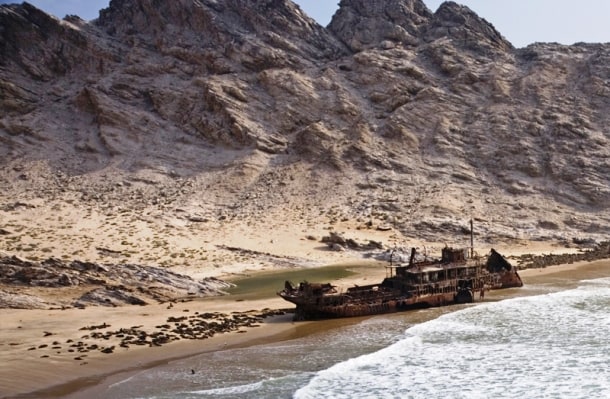Creepy Skeleton Coast Photos, A Place You Might...

One of the coast's best-known wrecks is a British liner, the Dunedin Star, beached by her master after hitting a reef in 1942. All 106 survivors were salvaged but 3 crew members of a rescue boat died in the action.

In 1943, 12 decapitated skeletons of adult humans and a child skeleton were found on Skeleton Coast. Who the mysterious victims were and why they were beheaded nobody knows even today.

The Skeleton Coast can be explored from a plane or 4WD vehicles. For obvious reasons, the travel agencies still refuse to provide boat excursion of the area.

Most of the bones found on the Skeleton Coast belong to animals but some of them are human. Allegedly, many of the wrecked sailors wished they had died on the sea instead of the slow death on the coast.

Considerable part of the area was declared Skeleton Coast National Park in 1971. Covering an area of 6,500 square miles, the park is divided into a northern and southern section. The southern section is open to those with 4 wheel drive vehicles, while the north can only be reached by a fly-in safari.

The grey coastal fog that contributes to the spooky image of the Skeleton Coast is in fact a vital part of the ecosystem. It provides enough moisture for lichens and other desert adapted flora to survive here.

Many wrecked sailors died exhausted after walking for hundreds of miles through the barren Namibian landscape in search of food and water.

The coast is largely soft sand occasionally interrupted by rocky outcrops. The southern section consists of gravel plains, while north is dominated by high sand dunes.

Stretching over 310 miles on the western part of Namibia, the Skeleton Coast is littered with over a thousand of shipwrecks some of which have been laying there for centuries.

Namaqua chameleon is one of the animal species that managed to adapt to the harsh and dry Skeleton Coast landscape. The reptiles spend most of the time waiting for fog basking beetles to come out of their hiding places.

The Skeleton Coast has always been a place where animals as well as humans fought for life. This fabulous brown hyena is trying to capture a sea-lion puppy in a Cape Fria sea-lion colony.

While some shipwrecks have almost disappeared because of the extreme weather conditions and salt water, others are still in perfect shape, seemingly ready to set out for their voyage.

One of the very few indigenous tribes capable of living in such inhospitable land is the Himba people; semi-nomadic hunters and gatherers occupying the Kunene region in Northern Namibia.

The sand dunes of the Namib Desert move at speed of up to 50 feet per year, covering some of the skeletons while revealing others, such as these oryx antlers.

At every corner, there are reminders of someone´s tragic destiny. But it were not just sailors who met their end on the Skeleton Coast. This place also claimed lives of several pilots, including a Swiss a pilot Carl Neuer who got lost there in 1933.

The animal graveyards of Skeleton Coast are dominated by the colossal, bleached vertebrae of whales.
Load more items (5 more in this list)
Creepy Skeleton Coast Photos, A Place You Might Never Want To Visit
“Death would be preferable to banishment to such a country“. Allegedly, this is how Swedish explorer Charles John Andersson described the Skeleton Coast when he first saw it in 1859. This northern part of the Atlantic Ocean coast of Namibia ranks among the most feared and scary places on Earth and these 25 pictures will show you why.
 Login
Login





